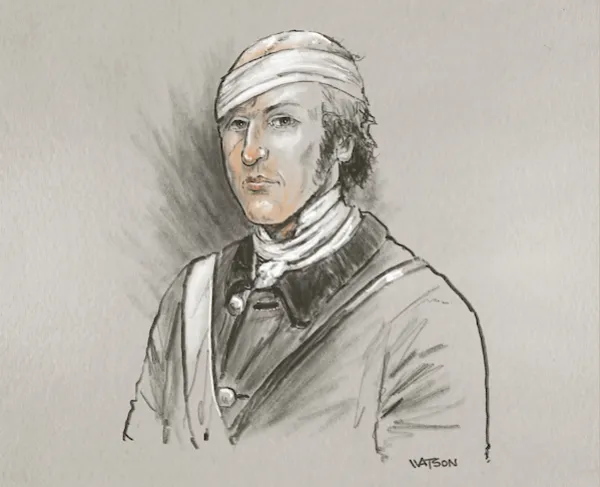Thomas Brown

Born in England on May 27, 1750, Thomas Brown grew up in well-to-do merchant family. By his mid-20s and interested in establishing himself as a gentleman planter in the British colony of Georgia, he recruited indentured servants, willing to pay their passage to North America. Brown obtained the rights to several thousand acres of land, partly in recognition of his charitable efforts and partly through his family’s wealth. He moved to Georgia and in 1774 founded the settlement of Brownsborough. A prosperous planter and local magistrate, he seemed to like his new life in the colony.
The mid-1770s had brought tension and protests to the colonies, as some protested the various taxes levied by the British parliament. Brown voiced his loyalty for the royal government in Georgia. When the Georgia Provincial Congress voted to join the Continental Association in July 1775 to organize petitions and further steps to seek relieve the political tension, Brown joined a loyalist counter-association.
Aware of Thomas Brown’s loyalist politics, rebellious Sons of Liberty members headed for his home on August 2, 1775. They ordered Brown to join the patriot cause. When he refused, the mob turned to violence, seizing Brown and inflicting brutal practices on him. He was partially scalped, burned, and tarred and feathered. His injuries also resulted in the loss of two toes and a fractured skull which left him with headaches for the rest of his life.
This assault did not stop Brown, though. He rallied and organized loyalists in Georgia and South Carolina during the early years of the Revolutionary War, continuing to support British rule of the colonies. Eventually, Brown fled to British East Florida to escape capture.
In Florida, Brown tried to contact and motivate Cherokee warriors to fight for the British, but this plan faltered. Next, he rallied other loyalists who had fled to the same region and organized the East Florida Rangers. Brown took his Rangers on raids into Georgia and South Carolina, causing havoc for the patriots.
Following their defeat and surrender at Saratoga, New York, in 1777, the British government officials and generals decided to shift their military focus to the southern colonies. Here, they hoped to retain the agriculturally-profitable colonies and had heard reports that many loyalists in the south would rally if a British army arrived in the region. British soldiers conquered Georgia in December 1778 and restored a royal government. Brown returned from Florida, no longer needing to lead the East Florida Rangers. Instead, he organized the King’s Rangers, a unit that served with the British armies in the southern campaigns for the remainder of the war. British leaders recognized Brown’s loyalty, and he became the superintendent of the Southern Indian Department, managing relations with Creek and Cherokee Tribes.
Brown and the King’s Rangers joined British soldiers in Savannah, Georgia, fighting against the French-American force that sieged the city in October 1779. Eventually, the patriot soldiers ended the siege and marched away, leaving British and loyalist forces in command of Savannah. Next, Brown and his unit helped to defend Augusta, Georgia, in September 1780.
Thomas Brown and King’s Rangers surrendered at Fort Cornwallis on June 5, 1781, after another siege. He was exchanged and allowed to return to British territory in East Florida. However, with the end of the Revolutionary War and the Treaty of Paris, Spain took possession of Florida. Brown desired to stay in a British colony and moved into the Caribbean, eventually settling in St. Vincent where he received a land grant. He was found guilty in a fraud case and spent two years in prison.
Thomas Brown spent the rest of his life on his Caribbean plantation, dying in 1825.





